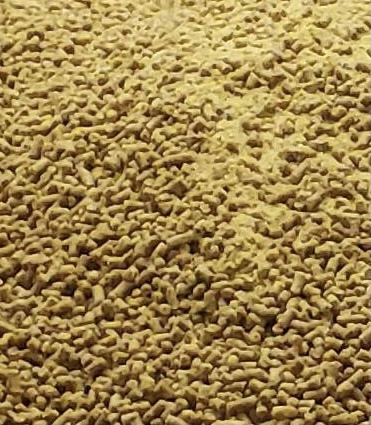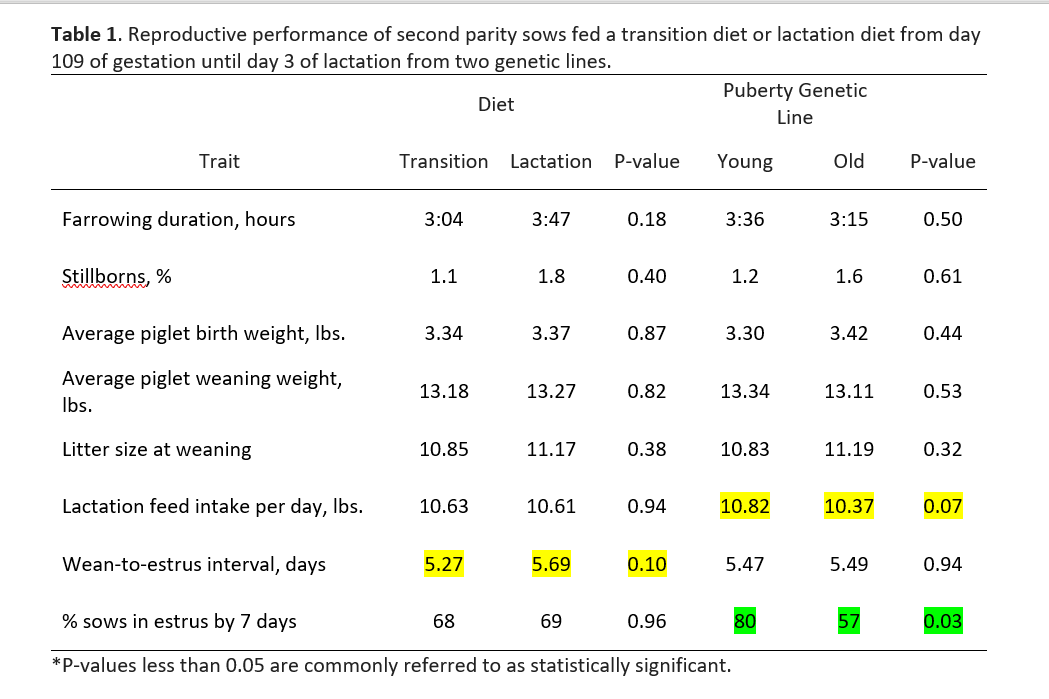There were a few surprises when we received the diet analysis back from the lab, and we believe a few nutritional factors may further explain the low percentage of stillborns observed in this study. Sows fed the transition diet tended to have a shorter wean-to-estrus interval than sows fed the lactation diet. Given the relatively low lactation feed intake of these sows, one may speculate the diet containing soybean oil helped sows meet their essential fatty acid requirements. However, the transition diet purposely confounded several technologies. Hence, one cannot clearly relate one piece of the transition diet to a given parameter.
Sows from the young puberty genetic line tended to have a greater feed intake during lactation when compared to old puberty line females. Young puberty sows also had a greater percentage of females exhibiting estrus by day 7 after weaning when compared to the old puberty genetic line (80% vs. 57%). This adds to the slim body of evidence suggesting younger puberty females experience less seasonal infertility than older puberty animals. Yet, further work in this area is needed.
We would like to thank the NCDA&CS Tidewater Research Station for their continued partnership, help and support. Contact Mark Knauer with questions.
References
Feyera, T., C. K. Højgaard, J. Vinther, T. S. Bruun, and P. K. Theil. 2017. Dietary supplement rich in fiber
fed to late gestating sows during transition reduces rate of stillborn piglets. J. Anim. Sci. 95:5430–5438.
Ramaekers, P. 2013. Effect of high fiber intake in sows in the transition period on piglet survival.
Pettigrew, J. 1981. Supplemental dietary fat for peripartal sows: A review. J. Anim. Sci. 53:107-117.
Manu, H, D. Pangeni, P. Wilcock, and S. Baidoo. 2018. The effect of superdosing phytase from 109 days
of gestation through lactation on farrowing duration, piglet and sow performance. J. Anim. Sci. Suppl. 2. 96:148.
Batson, K. L., H. Calderon Cartagena, R. D. Goodband, J. C. Woodworth, M. D. Tokach, S. S. Dritz, and J.
M. DeRouchey. 2019. Effects of high phytase supplementation in lactation diets on sow and litter performance. Kansas Agricultural Experiment Station Research Reports: Vol. 5: Iss. 8.
Vallet, J. L., L. A. Rempel, J. R. Miles, and S. K. Webel. 2014. Effect of essential fatty acid and zinc
supplementation during pregnancy on birth intervals, neonatal piglet brain myelination, stillbirth, and preweaning mortality. J. Anim. Sci. 92:2422–2432.
Holen, J. P., P. E. Urriola, M. Schwartz, J.-C. Jang, G. C. Shurson, and L. J. Johnston. 2020. Effects of
supplementing late-gestation sow diets with zinc on preweaning mortality of pigs under commercial rearing conditions. Transl. Anim. Sci. 4:1-12.
Feyera, T., T. F. Pedersen, U. Krogh, L. Foldager, and P. K. Theil. 2018. Impact of sow energy status
during farrowing on farrowing kinetics, frequency of stillborn piglets, and farrowing assistance. J. Anim. Sci. 96:2320–2331.
Miller, K., T. A. Kellner. 2020. Impact of pre-farrow feeding amount and timing on stillborn rate of sows.
J. Anim. Sci. Suppl. 3. 98:100.
K. M. Gourley, A. J. Swanson, R. Q. Royall, J. M. DeRouchey, M. D. Tokach, S. S. Dritz, R. D. Goodband,
C. W. Hastad, J. C. Woodworth. 2020. Effects of timing and size of meals prior to farrowing on sow and litter performance. Transl. Anim. Sci. 4:724–736
G. M. See and M. T. Knauer. 2019. Associations with four generations of divergent selection for age at
puberty in swine. J. Anim Sci. 97:2320–2328.




